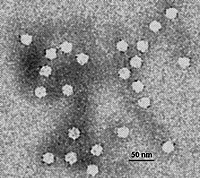
Photo from wikipedia
(1) Background: This study aimed to determine the risk factors for outbreaks of feline panleukopenia in shelters. (2) Methods: Four shelters (A−D) with 150 cats were included. Fecal samples were… Click to show full abstract
(1) Background: This study aimed to determine the risk factors for outbreaks of feline panleukopenia in shelters. (2) Methods: Four shelters (A−D) with 150 cats were included. Fecal samples were analyzed by parvovirus real-time polymerase chain reaction (qPCR), including culture and sequencing of qPCR-positive samples. Information on cats, husbandry, hygiene, and infection management was evaluated to determine risk factors for feline panleukopenia and parvovirus shedding by logistic regression. (3) Results: Feline panleukopenia occurred in 28.0% (42/150) of cats (0 in shelter D). Shedding was found in 48.7% (73/150) (A: 21/73; B: 29/73; C: 7/73; D: 16/73). Of 73 qPCR-positive fecal samples, 65.8% (48/73) were culture-positive; sequencing revealed feline panleukopenia virus (FPV) isolates in 34/48 samples and vaccine virus isolate in 14/48; canine parvovirus was not detected. Presence of feline panleukopenia was significantly more likely in cats from shelter A (p < 0.05), unvaccinated cats (p < 0.001), and young cats (4 weeks to 2 years; p = 0.008). Parvovirus shedding was significantly more common in young cats (p < 0.001), cats with feline panleukopenia (p = 0.033), and group-housed cats (p = 0.025). (4) Conclusions: Vaccination is the most important measure to reduce the risk of feline panleukopenia in shelters. Risk of parvovirus shedding is especially high in young, group-housed cats.
Journal Title: Viruses
Year Published: 2022
Link to full text (if available)
Share on Social Media: Sign Up to like & get
recommendations!